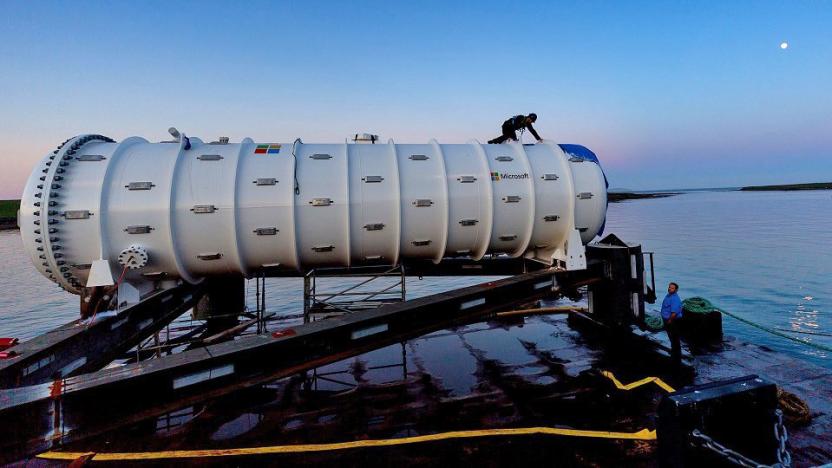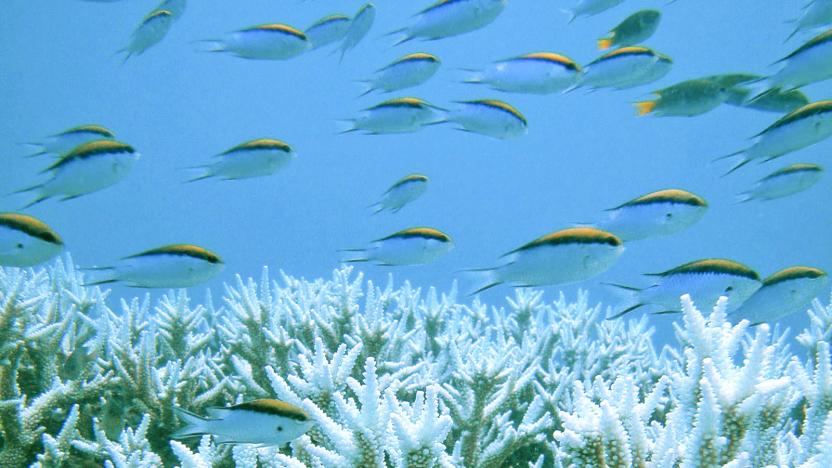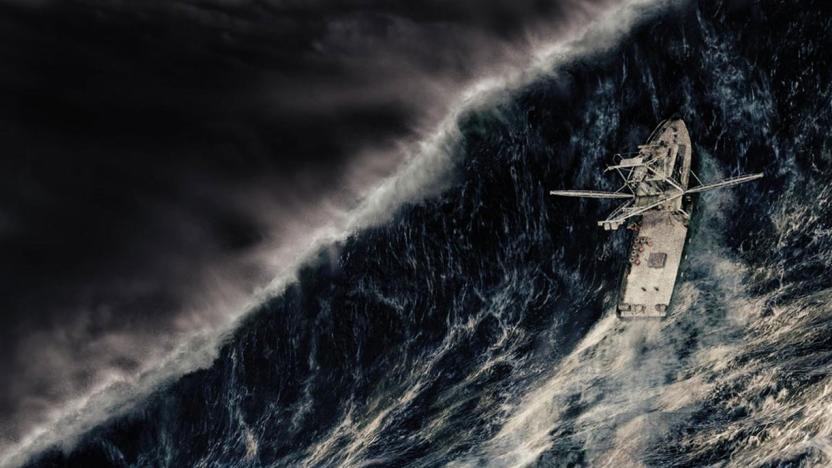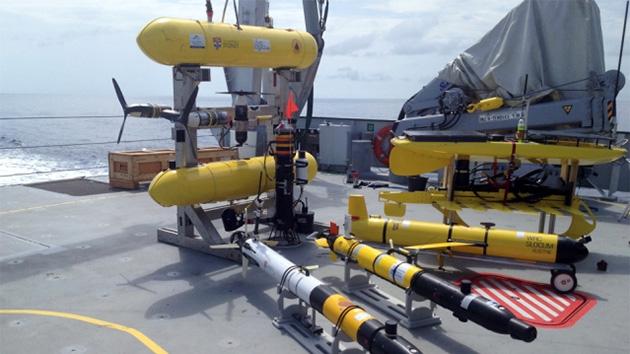sea
Latest

China launches a rocket from a ship for the first time
China has joined the US and Russia as the only nations to have successfully launched a rocket at sea. The National Space Administration's Long March 11 took off from a launchpad on a ship in the Yellow Sea today. The rocket carried five commercial satellites (including two for a company that plans to set up a global network of internet satellites) and two research-focused experimental ones.

Microsoft’s deep sea data center is now operational
Data centers are hot, noisy and usually inefficiently located. Microsoft's solution? Put them at the bottom of the sea. Following initial prototype testing, the company's years-long Project Natick is finally delivering Microsoft's vision of sustainable, prepackaged and rapidly deployed data centers that operate from the seafloor. Yep. Underwater.

The Great Barrier Reef's fate rests on slowing global warming
There's no question that the Great Barrier Reef and other coral fields are hurting as a result of rising water temperatures. But is there a relatively straightforward way to save them, or do they require more drastic action? Unfortunately, it's not looking good. Researchers have found that typical efforts to fight coral bleaching, such as improving the water quality or tightening fishing controls, haven't helped much at all. Whether an area was immaculate or dirty, it was just as susceptible to damage. The four large-scale bleaching events in the past two decades were the result of increased water heat -- that is, climate.

DARPA tests buoy network for fallback military comms at sea
It doesn't matter how many war machines you have under your command if you can't relay orders to their operators. Maintaining communications is just as important as firepower, and DARPA wants the armed forces to have as many contingencies as possible when networks go down or are actively jammed. Setting up a fallback network is even trickier on the open ocean, but the agency's Tactical Undersea Network Architecture (TUNA) program is well on its way to a solution. That solution being a collection of "node" buoys, deployed from ships or planes, that are tethered together by fiber optic cables to create a radio frequency data network.

ICYMI: Sea power could take wind power's bragging rights
try{document.getElementById("aol-cms-player-1").style.display="none";}catch(e){}Today on In Case You Missed It: Nova Innovation is installing the world's first tidal power generators along the coast of Scotland, which are able to produce 100 kilowatts of power each. The UK Carbon Trust estimates the tidal energy market will be worth $165 Billion by 2050. The P-Laser that strips rust in an instant is here, and if you're as into amazing dogs as we are, you must see the nicknozzy YouTube channel. As always, please share any interesting tech or science videos you find by using the #ICYMI hashtag on Twitter for @mskerryd.

328 foot-long floating barrier will collect ocean trash
There are numerous efforts underway to clean the world's oceans, but The Ocean Cleanup is testing what may be both the simplest and the most ambitious. It just launched a 328 foot-long prototype floating barrier that will collect trash floating in the North Sea. If it can survive the rough conditions of those waters, the plan is to deploy a 62 mile-long (!) barrier in the Pacific Ocean and reduce the size of the notorious Great Pacific Garbage Patch -- the hope is to halve the size of the trash field in 10 years.

MIT builds an early warning system for sailors
MIT believes that it's developed an early warning system for rogue waves that could save the lives of sailors. Currently, predicting when a ten foot high wave is going to crash across a ship takes a room full of supercomputers. That's not helpful for the scrappy fishing boats you see on Discovery Channel shows like Deadliest Food Grabbers and Gruff Seamen at Sea. That's where this new method from Themis Sapsis and Will Cousins comes in, which spot impending trouble and alert crews to batten down the hatches.

ICYMI: Underground AI delivery, sea life discovery and more
#fivemin-widget-blogsmith-image-255157{display:none;} .cke_show_borders #fivemin-widget-blogsmith-image-255157, #postcontentcontainer #fivemin-widget-blogsmith-image-255157{width:570px;display:block;} try{document.getElementById("fivemin-widget-blogsmith-image-255157").style.display="none";}catch(e){}Today on In Case You Missed It: The Xenoturbella deep sea creature doesn't have a brain, eyes or functional gut, but its genetics prove it is one of the oldest forms of ocean life. Also, it looks like a discarded purple sock.

Automatic garbage bin promises to clean the oceans
Take a close look at the water in your local marina and you'll probably shudder at the amount of waste floating around. You'd practically need a dedicated clean-up crew to make it safe, wouldn't you? However, a pair of Australian surfers think they have a better way. Their crowdfunded Seabin promises to clean up marinas (and by extension, the ocean) through the one-two combo of a natural fiber garbage bin and an automated, above-the-water pump. It's almost too simple a concept, but it seems to work -- it sucks in all kinds of filth (including oil) and spits out clean water. You'd ideally leave a bunch of Seabins running at the dock all day, keeping the water relatively pristine.

Xprize offers $7 million for exploring the ocean floor
After years of focusing on moonshots and other lofty goals, the Xprize Foundation now hopes to inspire innovation in the opposite direction... in a very literal sense. Its new Shell Ocean Discovery Xprize is offering a total of $7 million in awards to teams that can deliver robotic exploration of sea floors as deep as 4,000m (13,123ft). The $4 million grand prize and a $1 million runner-up prize will go to the groups that deliver the sharpest maps on top of meeting baseline requirements for autonomy, depth and speed. The top 10 teams will split a $1 million milestone prize, while the National Oceanic and Atmospheric Administration is chipping in another $1 million for teams that spot objects through biological and chemical clues.

MIT gave exploring robots a way to plan underwater missions
Forget those teensy deep-sea submersibles cradling crews of brave scientists -- the future of underwater exploration might be led by robots that can do their own thing. MIT engineers, led by professor Brian Williams, cooked up a system that lets autonomous underwater drones figure out and act on the nitty-gritty details of their missions without the need for meticulously laid-out plans.

The Big Picture: Satellite imagery details ocean depths with new maps
Harnessing data from two satellites, scientists at Scripps Institution of Oceanography at UC San Diego have built a new map of the deepest parts of the ocean. Combining info from the European Space Agency's (ESA) CryoSat-2 and gravity readings from NASA's Jason-1 with existing research, the team is able to show details that include undersea mountains and "little-studied remote ocean basins." The project's report explains that "one of the most important uses of this new marine gravity field will be to improve the estimates of seafloor depth in the 80 percent of the oceans that remains uncharted or is buried beneath thick sediment." Still curious? Peruse more the findings here.

India plans to build the world's largest floating solar farm
Solar farms need three things: sunlight, photovoltaic panels and a huge expanse of land. It's the third in that list that's hampering green efforts in countries like India, where space is scarce and therefore very expensive. That's why India is copying Japan's (pictured) idea of building floating solar farms out on the water, saving a fortune in land costs and helping to prevent evaporation in the hottest months. A partnership between India's national hydroelectric company and Kolkata's college of renewable energy plans to build a 50 megawatt floating solar farm -- one of the world's largest -- at some point in the future. Before that, however, a small pilot project will be constructed in a lake in Kerala in south-west India later this year which is expected to generate around 12 kilowatts of power. While we can't cover all of the world's oceans with solar panels, it does seem like a clever fix while scientists continue to work on the supercritical steam issue.

Eat your crew to stay afloat in Sunless Sea, now on Steam
Failbetter Games' dark, top-down nautical exploration and survival game Sunless Sea is now available on Steam Early Access. To celebrate its arrival, the developer is discounting the game by 10 percent ($17.09) until Tuesday, July 8. Sunless Sea, which first arrived in alpha form in mid-June on the Humble store, has players exploring an underground ocean in which every decision made impacts a "non-linear, choice-heavy, personalized experience." In order to survive, captains will need to fight large creatures and make tough decisions, such as eating their dead. The game is set in the same universe as one of the developer's previous game, Fallen London, and draws influences from games like FTL: Faster Than Light, Sid Meier's Pirates and Don't Starve. Sunless Sea earned £100,803 ($161,769) on Kickstarter in October 2013, and uses Failbetter's own narrative-focused StoryNexus engine (which it also used for Fallen London). Random House put the engine to use in April 2013 with the free-to-play Black Crown. [Image: Failbetter Games]

President Obama's Twitter and Facebook accounts targeted in Syrian Electronic Army hack
After tackling The New York Times, Twitter images and several other high-profile social media accounts, the Syrian Electronic Army has now struck the online presence of President Obama. A string of tweets were sent from the @BarrackObama account and messages posted to the President's Facebook fan page earlier today with links to SEA YouTube content. The source of the breach has been traced to a third-party URL shortener and not a takeover of the accounts themselves, letting the hackers redirect any links sent out by members of Organizing for Action to SEA links. It also appears that the organization was able to gain access to a campaign-related Gmail account as it posted a screenshot of the inbox. Control of the URL tool looks to be back in the hands of Obama's team as Facebook links are no longer redirecting, but Obama's official Twitter handle has been suspended for the time being.

DNS hack takes The New York Times offline (update: Twitter images were affected too)
For the second time this month, The New York Times has gone offline. This time around, the Syrian Electronic Army is likely to blame, with a Domain Name System (DNS) hack crippling the news org's online operation. The NYT's web servers are still online, however, so the publication has begun tweeting out direct IP links to recent articles. Meanwhile, Twitter itself may be vulnerable. Hackers have managed to modify some of the registration data, including the contact email address, suggesting an attack on the social site may be imminent. Update: According to a tweet from the paper's official account, it's temporarily publishing updates at news.nytco.com. Update 2: Twitter has confirmed the twimg.com domain used for images and photos was among those affected. According to the post, the original domain record has been restored and no user information was affected.

DARPA unveils plans for undersea payloads that surface on command
DARPA already intends to set a drone ship out to sea, and now it's revealed plans for undersea payloads that lie dormant for years and launch themselves to the surface when remotely commanded. Dubbed Upward Falling Payloads, the containers will carry non-lethal cargo such as small UAVs or networking hardware, and take advantage of the "cheap stealth" their position underwater grants them. Since the vision is to have a fleet of UFPs spread throughout ocean floors, it'll help the Navy "get close to the areas we need to affect, or become widely distributed without delay," according to DARPA Program Manager Andy Coon. DARPA is aiming to tap engineering talent from telecom companies to the oil exploration industry in order to solve challenges such as communications used to wake up payload nodes and launching them to the surface. There's no word on when UFPs will begin lurking sea floors, but DARPA is already looking for proposals to help build them. [Image credit: Alwbutler, Flickr]

Scientists estimate at least one third of marine species remain unknown to humans
It's been said that we know more about space than we do about our own ocean, and now a group of scientists have quantified what sea creatures we may still not know of. After compiling an open access, online database of known marine species with the help of more than 270 experts, researchers estimate that the briny depths may be home to a total of one million species, with one third of them potentially remaining entirely unknown. Of the grand total, humans have described roughly 226,000 -- more than 20,00 of which in the past decade -- with another 65,000 tucked away in collections awaiting a write-up. Since previous estimates have been based on rates of species identification and other factors, these latest figures are considered more accurate. The effort's researchers hope that this data will be used as a reference for extinction rates and conservation. Hit the first source link below to dig through the compendium, aptly-named the World Register of Marine Species, for yourself. [Image credit: NOAA's National Ocean Service, Flickr]

Google Street View gets its first underwater panoramic images, ready for desk-based scuba expeditions (video)
After working on its sea legs for some time, Google Street View is ready to take users on virtual scuba expeditions through six living coral reefs with the first underwater panoramic images to hit the service. In partnership with The Catlin Seaview Survey, Mountain View created the on-rails snorkeling experiences using undersea pictures from Heron, Lady Elliot and Wilson Islands at the Great Barrier Reef, Molokini Crater and Hanauma Bay in Hawaii and the Apo Islands in the Philippines. Combined with views from Chichen Itza and Teotihuacan, the new underwater tours might make for a respectable, desk-based vacation. Interested in paddling through the briny depths? Head past the break for a short preview or hit the source links below to dive right in.

Autonomous Wave Glider bot launched to track sharks, beam real-time data to your iPhone and iPad
When they're not breaking world records, fuel-hating Wave Glider seabots like to indulge in other hobbies, like shark tracking. One of the vessels has just been launched off the coast near San Francisco (vid after the break), adding a mobile worker to the existing local network of buoy-mounted receivers. They monitor the movements of electronically tagged sea life, including the fearsome Great White, picking up signals within a 1,000-foot range while researchers from Stanford University analyze the data from the safety of the shore. Better still, the free Shark Net iOS app gives anyone the chance to track these things, and activity should increase as the monitoring network (hopefully) expands along the west coast and more bots are introduced. You didn't think the world's fascination sharks was limited to only a single single week, did you?










